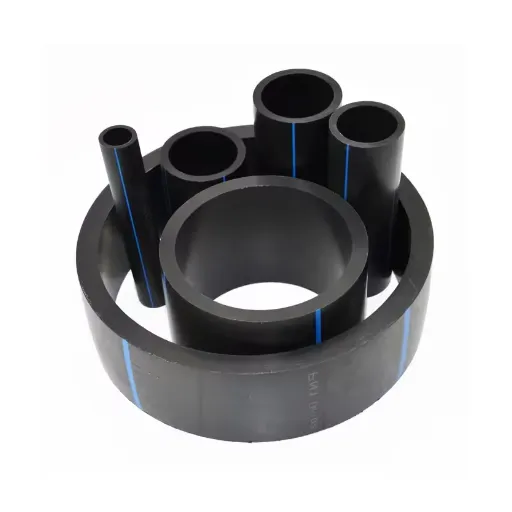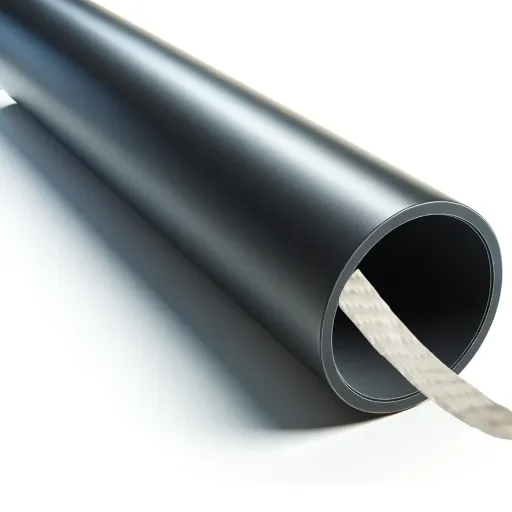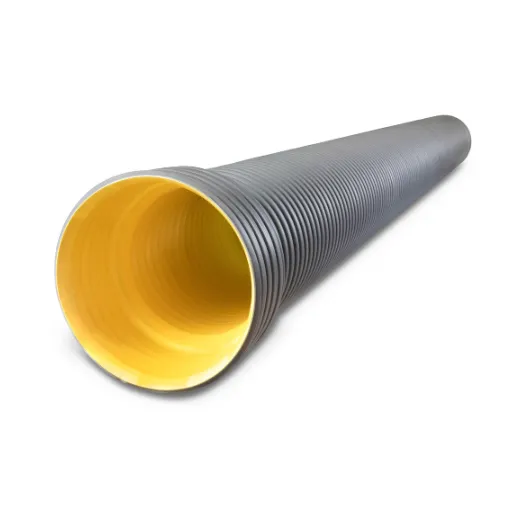When it comes to designing efficient drainage systems for culverts, stormwater management, and other critical infrastructure projects, the choice of materials is paramount. High-Density Polyethylene (HDPE) dual-wall corrugated pipe has emerged as a game-changing solution, offering unprecedented durability, flexibility, and performance. This guide will explore everything you need to know about HDPE dual-wall corrugated pipes—what makes them superior, their practical applications, and why they’re increasingly the preferred choice for engineers and contractors alike. Whether you’re managing large-scale construction or tackling a smaller-scale drainage problem, understanding the capabilities of this advanced piping system can transform the way you approach your projects.
What is HDPE Double Wall Corrugated Pipe and How Does It Work?

Understanding the Dual Wall Design: Corrugated Exterior and Smooth Interior
DWC pipes have an inner smooth layer and an outer HDPE layer that is corrugated, resulting in high strength and efficiency. The outer layer is intended to withstand tremendous external loads, like the soil’s weight in an underground setting. In this way, the design achieves an improved structural strength without using too much materials. This will save costs and retain durability.
The inner smooth layer, on the other hand, maximizes fluid flow. The movement of liquids such as stormwater, sewage and irrigation water is more efficient with low surface roughness. This layer also aids in clog-free sediment capture, reducing maintenance.
With modern developments in the technology of HDPE materials, additional attributes are obtained. The pipes can now transport aggressive acidic or alkaline fluids because of increased strength against corrosive materials. Installation and transportation are now easier due to increased flexibility and lightweight of the pipes, especially in difficult terrains. The dual wall design also improves structural performance, which increases efficiency when used for drainage and piping systems.
HDPE Properties and Advantages for Drainage Applications
The complex physical and chemical properties of HDPE make it a type with unparalleled qualities for drainage systems. Moreover, its incredible impact resistance effectively minimizes the likelihood of cracking or deformation, even under extreme conditions. This is further supported by its impressive tensile strength, meaning it can endure both high-load and low-load applications. The HDPE also sustains critical damage and does not fail under stress, cracks, or deformation in extreme conditions. One notable advantage of HDPE is its impressive resistance to a wide range of chemicals, including salts, oils, and acidic or alkaline substances, which vastly increases the lifespan of systems managing wastewater or industrial effluents.
In addition to that, leak-proof HDPE piping systems mitigate interaction with biological factors and the environment, such as fungal or bacterial growth, enabling sustained operational integrity. These pipes also maintain structural integrity in temperatures ranging from -40°F to 140°F, allowing for versatility in diverse climatic conditions. Moreover, these polymer pipes’ inner surface is smooth, which markedly reduces friction. This greatly improves flow efficiency in drainage and irrigation systems, preventing sediment or debris buildup and enhancing drainage efficiency.
Considering sustainable development goals, High-Density Polyethylene (HDPE) is another material that has strong characteristics of being an eco-friendly option as it is fully recyclable. Further, its production process is more energy-efficient in comparison with PVC pipes or metal pipes, further decreasing carbon emissions. With these advantages, HDPE has become the primary component for not only drainage systems but also sewage transport systems, agricultural irrigation, and even stormwater management systems.
Comparing HDPE Pipe to Concrete and Metal Pipe Alternatives
While analyzing the advantages of HDPE pipes over concrete or metal alternatives, the weight of the material, durability, cost-efficiency, and even the environmental impact must be considered. The same applies when looking at HDPE pipes: they are much lighter in comparison to concrete or metal pipes, which helps in reducing transportation and installation fees. Their lightweight nature also enables faster deployment at various stages in construction, which helps in minimizing labor expenses as well.
Analyzing the durability of HDPE pipes, one finds that they have exceptional resistance to corrosive scaling and chemical interactions, which are common in metals and concrete systems. For example, metal pipes are susceptible to rust when exposed to moisture or other corrosive substances. Similarly, concrete pipes can be subjected to freeze-thaw cycles or chemical corrosion attacks, which cause them to corrode over time. In comparison to all of this, HDPE pipes are structurally intact when exposed to an array of chemicals and environmental forces, which enhances their operational lifespan.
When looking from the lens of cost-efficiency, HDPE proves to be a more competitive solution. Even though the initial cost of HDPE is higher than concrete in some cases, their long service life coupled with low maintenance requirements leads to lesser total expenses in the long run. Unlike HDPE pipes, metal pipes, even though they are more robust, require costly protective coatings along with regular maintenance on a frequent basis which increases their life cycle expenses.
Lastly, the ecological consequences of the resource are critical for today’s sustainability-focused markets. The fact that HDPE pipes are fully recyclable adds to their value within a circular economy framework. The production of HDPE consumes much less energy than its concrete or metal counterparts, which go through much more rigorous resource-extractive processes. Moreover, leak-resistant joints in HDPE pipes further mitigate water loss and contamination as compared to metal pipes, which tend to develop leaks at welded joints or fittings over time.
Taking into consideration all of these factors, it makes sense why HDPE pipes are considered the most efficient option for water distribution, sewage, and even stormwater management, offering optimal performance, cost effectiveness, and environmental care.
How to Properly Install Dual-Wall Corrugated HDPE Drainage Pipe?

Site Preparation and Soil Considerations for HDPE Pipe Installation
For the correct installation and ongoing functionality of dual-wall corrugated HDPE drainage pipes, proper site preparation is essential. First, inspect the site for possible hindrances such as boulders, loose rocks, utility lines, etc. Also, remove any vegetation cover since it leads to soft spots in the bedding over time.
You must excavate the trench to the desired depth, width, and length. These dimensions should be relative to the diameter of the pipe and the top cover. The sides of the trench should comply with legal and safety slope regulations to prevent slipping and trench collapse during installation. To lessen the possibility of damaging the pipe during installation, ensure the trench bottom is devoid of sharp and coarse protrusions. An even trench bottom is suggested to improve installation results.
While evaluating the soil, check the native soil’s ability to compact and bear loads. Sufficient backfill material for the integrity of HDPE pipes is essential. Bedding materials such as gravel and sand are useful for offering maximum drainage and compaction because they are granular materials.
Loosely compacted, technologically unstable soils like clay or silt may need further stabilizing measures such as geotextiles or specific fill materials to avoid vertical motion and maintain the pipes’ alignment.
If these considerations are incorporated during the preparation of the site, it can help in preventing deflection of the pipes, inefficient joint connective strength, or reduction in the support provided by surrounding structures, thus enhancing the overall efficiency and durability of the drainage system.
Proper Backfill Techniques for Maximum Pipe Strength and Performance
For a pipe to function well and maintain its required performance metrics, as well as its structural durability, proper backfilling must be applied. Sand or crushed stone are granular material choices that come highly recommended due to their positive compaction attributes as well as ease of placement. These materials reduce the risk of voids, which can hinder the distribution of load or even cause deflection of the pipe under external loads.
As with any other construction procedure, the backfill process has compaction as one of its components. Each fill should be compacted to no less than 90% of the maximum dry density of the soil as indicated from the Proctor test, with proper moisture content being crucial to achieve such levels of compaction. Dry or overly saturated conditions severely impair compaction effectiveness. Backfilling should also be done in layers, with each layer being 6 to 8 inches thick. The moisture content of backfill material influences compaction, with the use of mechanical tampers or vibratory compactors allowing for the required levels of compaction.
Also, the haunch zone, which is the area immediately above and below the retrieval well pipe, needs to be compacted correctly. Selecting the correct material can ensure that the pipe retains its form and is able to carry a load. Inadequate support in the haunch region will create a dominant stress within the structure, which increases the chance of creating a joint failure or cracks along the length of the pipe.
These guidelines for backfilling, as well as when dealing with traffic or varying soil conditions, help avoid intense environmental destruction. With effective material and layering selection, accurate compaction, precise placement, and ideal material selection, minimization of settlement risks is possible, alongside improvement of the entire drainage system performance.
What Fittings and Connection Options are Available for HDPE Corrugated Pipe?
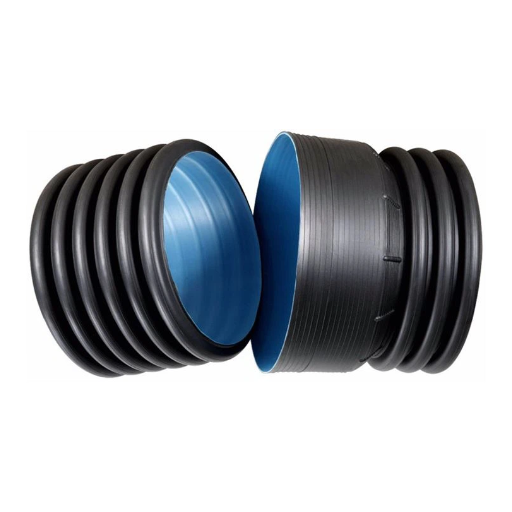
Bell and Spigot Design for Soil-Tight Connections
The purpose of the bell and spigot joint design on HDPE corrugated pipe systems is to ensure that both soil-tight and watertight seals are made. One end of a pipe has a bell, and the other has a slightly smaller spigot. Unlike other methods of connection, this allows for secure and interlocking fits. The piping system’s life and integrity are also enhanced by the precisely manufactured bell and spigot system, which contains gasketed seals that stop the fines and debris from infiltrating the piping system.
The bell and spigot joint is optimal for piping as it is highly reliable. This flexibility, along with a soil’s ability to move, requires thermal expansion to shift without compromising the connection. Additionally, the joint is implemented into the sewer network, store, and culvert, where maintenance and installation requirements are minimized while efficiency is maximized.
Moreover, technical refinements such as high-performance gaskets made from thermoplastic elastomers, being welcomed by the advancements in material science as they offer more resistance to chemicals, environmental damage, and wear deepens the scope of bell and spigot systems. These changes help in accommodating both high-flow and surcharge scenarios and evolving requirements of modern infrastructure projects.
Gasket Joint Systems for Watertight Applications
Gasket joint systems are designed to provide the highest watertight integrity and sealing effectiveness in sewage, stormwater, and potable water systems, with both sealability and water resistance being critical factors. The construction of these systems utilizes custom-cast gaskets made from EPDM (ethylene propylene diene monomer) and nitrile rubber gaskets selected for severe ozone, UV attack, and chemical resistance. A compression-seal design guarantees joint reliability by providing uniform contact pressure throughout the sealing surface; even the presence of external loads, internal pressure changes, or variations to pressure differentials do not disrupt the balance.
New custom multi-lip profiles with auxiliary ribs for additional sealing redundancy for critical seal applications add greater risk mitigation for leakages. These inventions reduce failure risk throughout the lifespan by increasing reliability with minimal likelihood of service lifetime system breakdowns.
Results show that installed correctly with quality control throughout the manufacturing process, gasket joint systems yield a 0.1% leak rate, which is below industry benchmarks. Such values aid in lowering maintenance expenses while forming default standards for nature conservation and low impact pollution projects that seek longevity and sustainability, proving ideal for expansive durability solutions deployments with lifecycle cost effectiveness.
Available Fittings for Complete Drainage System Design
To ensure functionality and compliance with operational needs, any complete drainage system design must include an assortment of high-precision engineered fittings that are dry properly to avoid water expansion. Drainage systems use many common fittings such as couplings and reducers that allow pipes to be securely connected with minimum leakage and make pipes of different diameters to allow lesser or greater flow depending on load. Bends and elbows are other integral components of efficient pipe systems that allow for sharp redirections of flow around obstacles without loss of system power.
More advanced designs also feature inspection chambers and other access fittings for routine system maintenance. Regular maintenance, as well as cleaning, is highly important as it prevents blockages from occurring and maintains peak performance, especially in highly used systems. Waterproof covers with gaskets also aid the point over their inspections greatly by stopping water from getting in or flowing out.
Modern advances in engineering have enabled the production of features using highly durable materials such as PVC-U, HDPE, or stainless steel. Being resistant to corrosion, changing temperature, and even exposure to chemicals prolongs the lifespan of the system considerably, which also reduces upkeep costs. Also, selection and proper integration of all parts into the fitting network of the drainage will help enable hydraulic stability and ensure the system will work for a long time throughout different structural applications.
What Makes HDPE Dual-Wall Corrugated Pipe the Superior Choice for Drainage Systems?
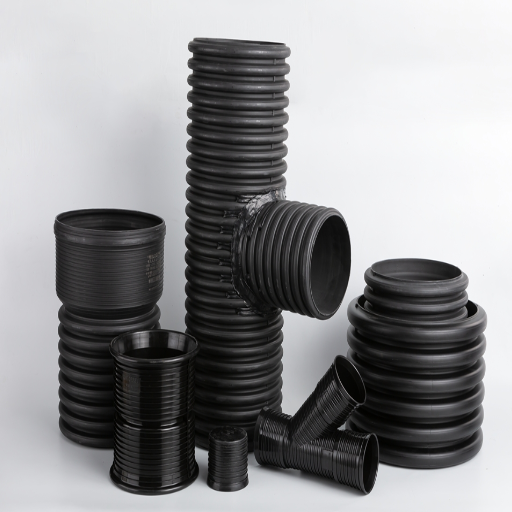
Corrosion Resistance and Long-Term Durability Advantages
Superior resistance to corrosion and abrasion is HDPE dual wall corrugated pipes distinguishing feature. Compared to traditional concrete or metal, HDPE’s chemical inertness offers protection against harshly acidic or alkaline wastewater and soil. This important attribute reduces the likelihood of structural deterioration over time. The pipe will maintain performance in harsh environments.
Moreover, HDPE pipes have outstanding durability over long periods because of their high abrasion resistance and low stress cracking. The flexibility and impact strength due to their molecular structure makes them less vulnerable to damage during installation and high-pressure loading. Research has shown that under normal operational conditions, HDPE dual wall corrugated pipes can sustain structural integrity for over 50 years, which offers unmatched lifespan value. Their resilience against UV degradation enhances outdoor usefulness and broadens their applications without functional impairment.
Besides these advantages, new developments in material engineering have improved the pipes’ ability to withstand varying hydraulic loads, optimizing their structural strength. This enhances flow efficiency and reduces blockage risks over time. As a whole, these features make HDPE dual-wall corrugated pipes the best choice for drains that require low maintenance and high reliability.
Hydraulic Flow Benefits of Smooth Interior Corrugated Pipe
The hydraulics and the smooth internal surface of a corrugated pipe both work in unison to construct a well-optimised system. Such a design has the benefit of reducing friction losses during fluid transport, which, for hydraulic pipes with smooth interiors made of HDPE, is the roughness Manning’s coefficient. Such a coefficient ensures that the flow rate is significantly higher compared of rough-walled materials such as pipes made of concrete or clay. As was seen with HDPE pipes, the interior surfaces with less friction lead to an increase in the flow rate as compared to pipes made of concrete or clay.
Moreover, the designed interior cavity enables smooth internal flow to achieve the self-cleansing velocity needed to avoid sediment deposition or clogging, more so for systems managing wastewater or stormwater. CFD studies underscore streamlining the flow inside smooth-walled, energy-saving, and gravity-powered systems, which helps reduce the turbulent energy dissipation. This free flow reduces the long-term operational costs and helps promote steadfast, sustainable infrastructure by maintaining uninhibited hydraulic capability during the entire lifespan of the pipe.
Such advanced designs and optimised features in pipe hydraulics make the latter a perfect fit for drainage systems across different municipalities and large agricultural and industrial setups, which require enhanced performance even during variable flow conditions.
Cost Effectiveness Compared to Traditional Pipe Materials
Modern pipe designs, particularly those based on employing polymers or advanced composite materials, are more cost-effective than traditional alternatives like concrete, steel, or clay pipes. This is due to several reasons with the first being the materials’ lightweight nature greatly cutting down on transportation and installation costs. Cost is further reduced during labor as polymer pipes, for instance, can weigh up to 90% less than concrete alternatives making handling a lot easier.
Along with modern materials being easier to handle, their durability and inability to corrode also help bring maintenance and replacement costs down, saving money throughout the materials’ operational lifespan. Studies show pipes made out of high-density polyethylene (HDPE) can last anywhere between 50 to 100 years under optimal conditions. Such longevity allows for fewer system interruptions and lifecycle expenses.
Last, modern methods of manufacturing have opened the window to optimizing production efficiency by reducing material waste. Holistically, these factors allow next generation pipe solutions to surpass traditional piping system, making them more cost effective without compromising performance, sustainability, or resilience.
How to Determine the Right HDPE Corrugated Pipe Size for Your Project?
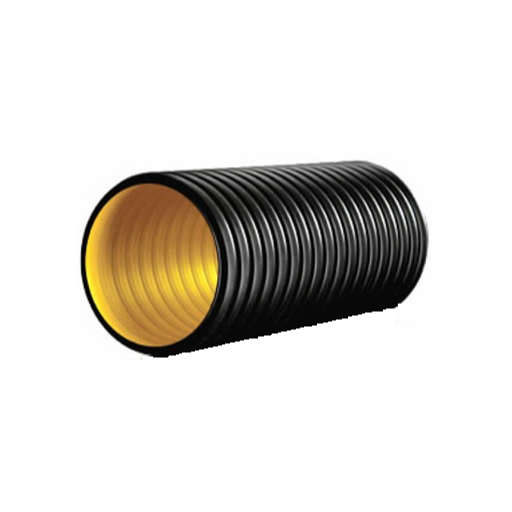
Calculating Flow Requirements and Pipe Diameter Selection
To determine the correct size of the HDPE corrugated pipe for a certain project, a precise estimate of the flow requirements needs to be made. The estimation needs to consider the amount of liquid the pipe needs to handle under different circumstances. Normally, this can be done using the Manning equation, which is very popular for calculating the flow in rough pipes considering the flow’s grade and diameter. For HDPE corrugated pipes, the Manning’s roughness coefficient is usually taken to be 0.012 because his material has a weak interior surface, resulting in a low resistance to smooth flowing fluids.
Knowing the hydrological characteristics such as average rainfall intensity, supposed to be drained areas, and dependency surface type so soil Boundaries and permeability coefficients ratio also can be unified to ensure effective peak flow containment. Alongside focusing on achieving project goals like pipe routes of installation slant and the intended depth, it is also equally vital to focus on the hydraulic measure reliability as well as maintainability throughout time.
Modern computing technology has automated the procedures even more by allowing complex simulations to be performed concerning geospatial and geospatial conditions. With these computations, alongside field measurements, engineers can select the most appropriate pipe concerning its size, efficiency, strength, code compliance, and other rules relevant to the project.
Load-Bearing Considerations and Soil Conditions
The overall structural integrity of the building foundation is heavily influenced by the geology of the area, so a thorough examination of these geological aspects is required during the preliminary phases of the project. The fundamental properties of a soil consist of its moisture content, density, internal stress, and friction, which directly impact the soil’s load-bearing ability. Modern Geotechnical Engineering Instruments make it possible for engineers to simulate various soil characteristics, enabling accurate calculation of load placement across different parts of the structure.
Modern approaches also integrate subsurface soil profiling by means of borehole excavation, CPT, and GPR. Moreover, some of the geological features that are rigorously monitored include the height of the water table, seasonal soil expansion or contraction, and other potential settlement gaps, which could lead to unwanted heaving and uneven load distribution.
With the incorporation of these sophisticated methodologies, foundational designs undergo thorough verification against prospective risks while observing uncompromised structural integrity, efficiency, and resilience built under industry standards.
Application-Specific Sizing for Culverts, Drainage, and Stormwater Systems
Effective drainage and stormwater systems require hydrological and hydraulic modeling that considers site-specific conditions and basin features. Relevant modeling elements that need to be incorporated are peak flow rates, soil permeability, catchment area characteristics, and precipitation intensity. Computational modeling implements modern tools for design scenarios and stagnation predicting algorithms, like 2D and 3D flow simulation software, which enhances accuracy in simulating water movement and design bottlenecks.
Ordinary and extreme conditions must be taken into account for culvert design, which usually relies on recurrence intervals like 10-year, 25-year, and 100-year storm events. Pipe slopes, roughness coefficients (Manning’s n), and drainage conveyance capabilities are critical design factors that optimize velocity and minimize sediment deposition for stormwater systems particulate in meeting regulatory requirements for discharge rate limits to mitigate downstream flooding and environmental damage.
Environmental factors, compliance, and computational efficiency can be maximized along with performance under ever-changing climatic conditions by using specialized engineering approaches and incorporating site-specific data.
References
Frequently Asked Questions (FAQs)
Q: What are the key specifications for HDPE dual-wall corrugated pipe?
A: HDPE dual wall pipe specifications typically follow ASTM F2306 and AASHTO M294 standards for 12″-60″ pipes, while smaller pipes (3″-10″) follow AASHTO M252. The pipe features a corrugated exterior for strength and a smooth interior for optimal hydraulic efficiency. It offers a minimum pipe stiffness of 10.8 psi, superior corrosion and abrasion resistance, and soil-tight or water-tight joint options. The dual wall design provides the perfect balance of structural integrity and flow capacity, making it an excellent alternative to reinforced concrete or corrugated metal pipe for drainage applications.
Q: What sizes of N-12 HDPE pipe are commonly available?
A: N-12 HDPE pipe is available in a wide range of diameters to suit various drainage requirements. Common sizes include 6″, 12″, 18″, 24″, and extend up to 60″ in diameter. The smaller 6″ size is ideal for residential and light commercial applications, while larger sizes such as 18″ and 24″ are commonly used for culvert systems, stormwater management, and major drainage projects. Each size of N-12 HDPE pipe maintains the same dual wall construction that provides both strength and smooth interior flow characteristics.
Q: How do pipes and fittings connect in an HDPE dual-wall system?
A: In HDPE dual wall systems, pipe and fittings connect using either bell and spigot joints or plain end connections with couplers. The connections can be specified as soil-tight for standard drainage applications or water-tight for environmentally sensitive areas. Installation is straightforward using the manufacturer’s fittings manual guidelines. The system includes a complete range of standard fittings such as elbows, tees, wyes, and reducers, with custom fittings available for special applications. The lightweight nature of HDPE materials makes handling and connection significantly easier compared to traditional materials like concrete.
Q: What advantages does corrugated dual-wall pipe offer over traditional materials?
A: Corrugated dual wall pipe offers numerous advantages, including exceptional durability, light weight for easy handling, and strength comparable to traditional materials. The smooth interior provides superior hydraulic efficiency, allowing smaller diameter pipes to achieve the same flow as larger traditional pipes. It features excellent resistance to chemicals, road salts, and corrosive soils, and can withstand freeze-thaw cycles without cracking. Unlike concrete or corrugated metal pipe, HDPE won’t rust, corrode, or deteriorate over time, resulting in a service life of 100+ years. Additionally, it’s environmentally friendly, being manufactured from recycled materials and itself being 100% recyclable.
Q: How does 6″ HDPE dual-wall pipe perform in residential applications?
A: The 6″ HDPE dual wall pipe performs exceptionally well in residential applications. Its lightweight nature makes it easy to handle without heavy equipment, while maintaining sufficient strength for typical residential loads. This size is perfect for foundation drains, yard drainage systems, and small culverts under driveways. The smooth interior of dual-wall pipe allows for superior water flow compared to single-wall corrugated or perforated pipes of similar diameter. It’s resistant to chemicals found in residential soils and can be installed as either a solid drain pipe for directed water flow or perforated for subsurface drainage applications.
Q: What installation considerations should be made when using 18″ or 24″ HDPE pipes for culverts?
A: When installing 18″ or 24″ HDPE pipes for culverts, several key considerations must be addressed. First, proper bedding with appropriate granular material is essential to provide uniform support. Backfill should be placed in layers and compacted to specifications by AASHTO standards. Minimum cover requirements vary based on traffic loads – typically 12-24″ for these sizes under roadways. End treatments should include proper headwalls or end sections to prevent erosion around the pipe ends. While the lightweight of HDPE makes installation easier than concrete alternatives, care must be taken to prevent flotation in areas with high groundwater by using proper anchoring techniques.
Q: What makes N-12 HDPE pipe suitable for culvert systems?
A: N-12 HDPE culvert pipe is ideally suited for culvert systems due to its unique combination of properties. The dual wall construction provides exceptional strength to handle traffic loads while maintaining a smooth interior for optimal flow capacity. Its superior corrosion and abrasion resistance make it ideal for conveying abrasive stormwater containing sand and gravel. The pipe is available in lengths up to 20 feet, reducing the number of joints needed compared to concrete pipe sections. N-12 HDPE pipe can be easily cut and adapted in the field, allowing for custom installations. Additionally, its lightweight significantly reduces installation costs by eliminating the need for heavy equipment typically required for concrete pipe installation.
Q: How does the hydraulic efficiency of HDPE dual-wall pipe compare to other materials?
A: HDPE dual-wall pipe offers superior hydraulic efficiency compared to many traditional materials. The Manning’s “n” value (a measure of flow resistance) for dual wall HDPE is typically 0.010-0.012, comparable to PVC and significantly better than concrete (0.013) or corrugated metal pipe (0.024). This smooth interior allows for faster flow velocities and greater capacity using the same diameter pipe. For example, a 24″ HDPE dual wall pipe can often handle the same flow as a 30″ corrugated metal pipe. This enhanced flow capacity means designers can sometimes specify smaller diameter pipes, resulting in material and installation cost savings while maintaining needed drainage performance.
Q: What are the environmental benefits of using HDPE dual-wall corrugated pipe?
A: HDPE dual-wall corrugated pipe offers significant environmental benefits. It’s often manufactured using recycled materials, reducing landfill waste and resource consumption. The pipe itself is 100% recyclable at the end of its service life. Its exceptional durability (100+ year service life) means fewer replacements and less construction disturbance over time. The watertight joining options prevent exfiltration of contaminated water into surrounding soil or infiltration of groundwater into the system. Additionally, the smooth interior reduces the energy needed for pumping in pressurized applications, and the lightweight nature of the pipe reduces transportation carbon emissions compared to heavier materials like concrete. All these factors make HDPE dual-wall pipe a sustainable choice for modern drainage systems.




